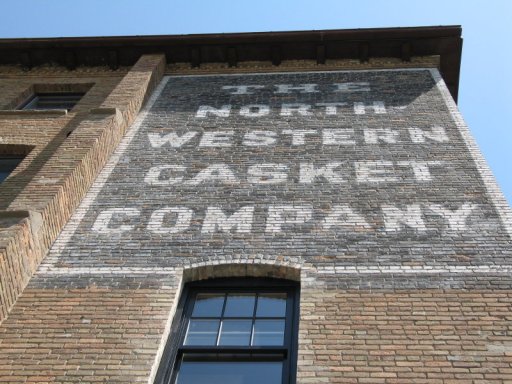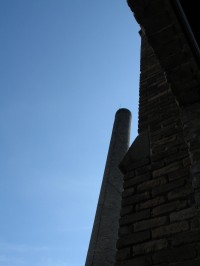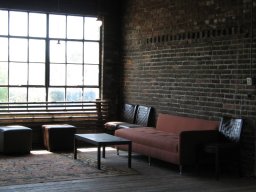
Halloween Spider Exit, Casket Arts Building, Minneapolis, Minnesota, October 2008, photo © 2008 by QuoinMonkey. All rights reserved.

Spider Walk, Casket Arts Building, Minneapolis, Minnesota, October 2008, photo © 2008 by QuoinMonkey. All rights reserved.

Casket Arts Halloween, Casket Arts Building, Minneapolis, Minnesota, October 2008, photo © 2008 by QuoinMonkey. All rights reserved.
There was a Halloween Open Casket event at the Casket Arts Building last weekend. We spent several days hanging out in our studio, visiting with community artists and art lovers who stopped by to view and talk about art.
One couple had just moved into the building and we were talking about how the entire 3rd floor was once filled with women who sewed silk casket linings for the Northwestern Casket Company. And the polished maple we were standing on contained patches of thrown away boards from the casket builders downstairs.
That got me to thinking about caskets and, well, things just snowballed from there. Here’s my short list of fun things to do on Halloween.
1) Take A Casket Decorating Class
All things associated with death, including obituaries, caskets, and burials used to be an art form. People spent painstaking hours building and decorating caskets with the art of Rosemaling or Dalmalning. And there are people who still excel at this craft.
Rosemaling is Norwegian decorative painting. In an interview, Casket Painting Uplifted by Folk Art Tradition, Alegria talks about how she got started in casket painting. It’s spiritual work for her:
I do what I do because I have been given opportunities to experience dying, death and loss in the biggest ways, and I want to take what I’ve learned and experienced and help transform grief to glory.
If you head over to the Alternative Funeral Monitor News, you can read the whole interview with Alegria and see a photograph of a casket with Rosemaling.
Here’s an excerpt:
I paint Folk Art, primarily Rosemaling, a Norwegian folk art. I also use other forms, including Dalmalning, which is Swedish flower painting, and Baurnermalerai, a Bavarian folk art. In fact, every country has specific ethnic folk art forms, with designs and patterns that have been used for centuries.
Rosemaling actually comes from the early itinerant painters who traveled throughout Scandinavia. They stayed with families, became part of the family and decorated precious dowry trunks, beams, walls, ceilings and pews in the churches for the people. This art helped to bring light, color and joy into the long, dreary, dark winters.
The patterns and designs invoked spirits that the wood carvers had first carved on the Viking ships, such as acanthus vines, serpents and dragons. The shapes have meanings which they incorporated into the designs of this early work.
In addition, in the earliest burial customs, people were buried wrapped in a shroud. Later, when customs started to change and people harvested timber and used planks of wood to make caskets to bury people in, the custom began of adorning and decorating caskets. The ancient motifs and designs I paint with rise from the subconscious that now really is a form of tribal art.
2) Learn To Build Your Own Casket
The North House Folk School up on the Harbor of Lake Superior in Grand Marais, Minnesota is offering a Build Your Own Casket class. I don’t know about you, but this looks fascinating and fun to explore. What better way to prepare for that final resting place.
There are photographs and more at the link below. Just scroll down the Woodworking page to get to the casket building class.
Bury Yourself In Your Work – Build Your Own Casket
Instructor: Randy Schnobrich
Session Options: 12/5/2008 – 12/7/2008
None of us are getting out of this alive, so you might as well bury yourself in your work. Join a growing number of independent-minded people looking for a more meaningful alternative to today’s burial arrangements. This course covers a range of important details such as: proper sizing, joinery, handle construction, hardware and design options.
The finished casket need not wait for a final departure before being put to use. Above-ground applications include use as bookshelves, coffee tables, storage containers and entertainment centers.
3) Read Old Obituaries (1920’s – 1950’s) & Write Your Own
This one offers immediate satisfaction. We’ve talked about the obits many times on red Ravine. After reading today’s obits, I’m stunned by the richness and character of the old obituaries, how people used to take time to honor people in death by writing about their lives.
Mom uses obituaries in her research on the family tree and they often lead to uncovering buried skeletons. What a treat! It makes me wonder if there used to be people in a community who excelled at writing obituaries, writers that the grief-stricken would turn to to write the obit of a lifetime.
Here’s a link to FR – FZ section of a few Wisconsin ancestral obituaries. And a little bit about the poetic character of Anton N. Freng in this short excerpt from his obituary:
Anton Nilson Freng was born in Brottom, Norway, on July 31, 1852, and died at his home in South Valley, town of Summer, on November 6, 1933, having lived 81 years, three months and six days. He learned the painting trade under Master Erick Alm. In 1873, the family immigrated to America, stopping at Chicago for a few weeks and then making their home in LaCrosse, Wisconsin.
A.N. Freng was a man of action. He served on his school district board for many years, was an organizer and director of the Osseo Canning Company, and served for thirty years as director and agent for the Pigeon Mutual Fire Insurance Company. He was secretary of the South Valley church for the past 45 years.
Mr. Freng was the leader in his community. He was endowed with more than ordinary amount of common sense and courage. His neighbors depended upon his counsel. He was a man of sterling character. He had a kind and jovial disposition. He was loved and respected by all who knew him well. His oft repeated phrase, “Another of our old and venerable pioneers has gone to his well-earned rest” has again come true, and may we add that the greatest of them all has gone.
Coming from a foreign country at the age of 21, not knowing a world of English and having had but little schooling, he rose to heights and power unsurpassed by many who had much greater advantages. He was great because he had ability, because he was honest and sincere. He expended his energies in the right direction, for the betterment and advancement of his community and country. The world is better for his having lived.
-Written by J. Reese Jones. THE WHITEHALL TIMES – NOVEMBER 15, 1933


Mr. Ghoul, & Pumpkin Man, Casket Arts Building, Minneapolis, Minnesota, October 2008, photo © 2008 by QuoinMonkey. All rights reserved.
Any takers? There’s nothing boring about death and dying folks. And for an extra special treat, visit Heather’s blog, Anuvue Studio. She goes crazy every Halloween with all things wild and wonderful.
Happy Halloween. Happy Day Of The Dead. Happy Samhain.



-posted on red Ravine, Friday, October 31st, 2008
Read Full Post »



















































